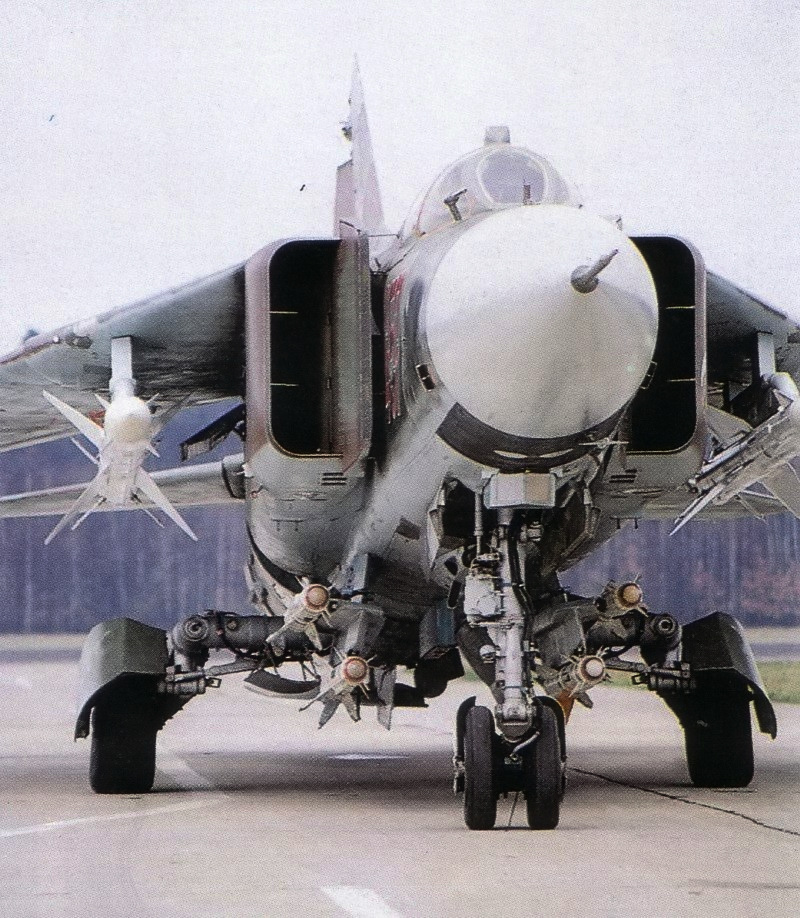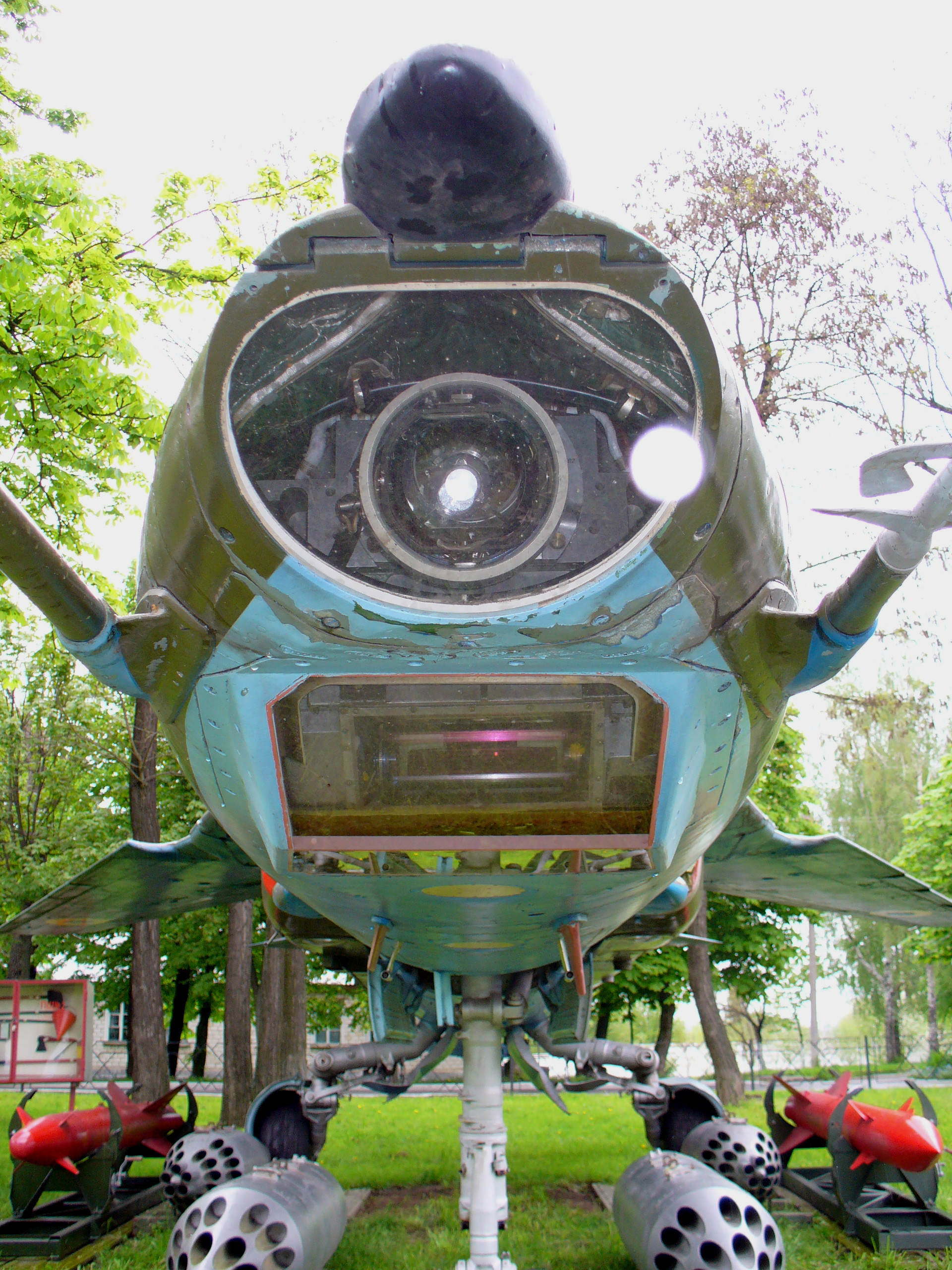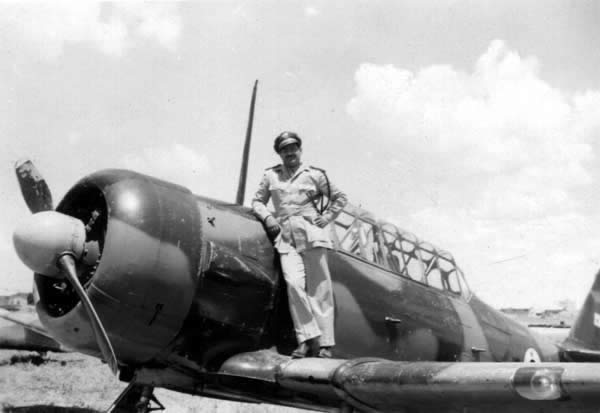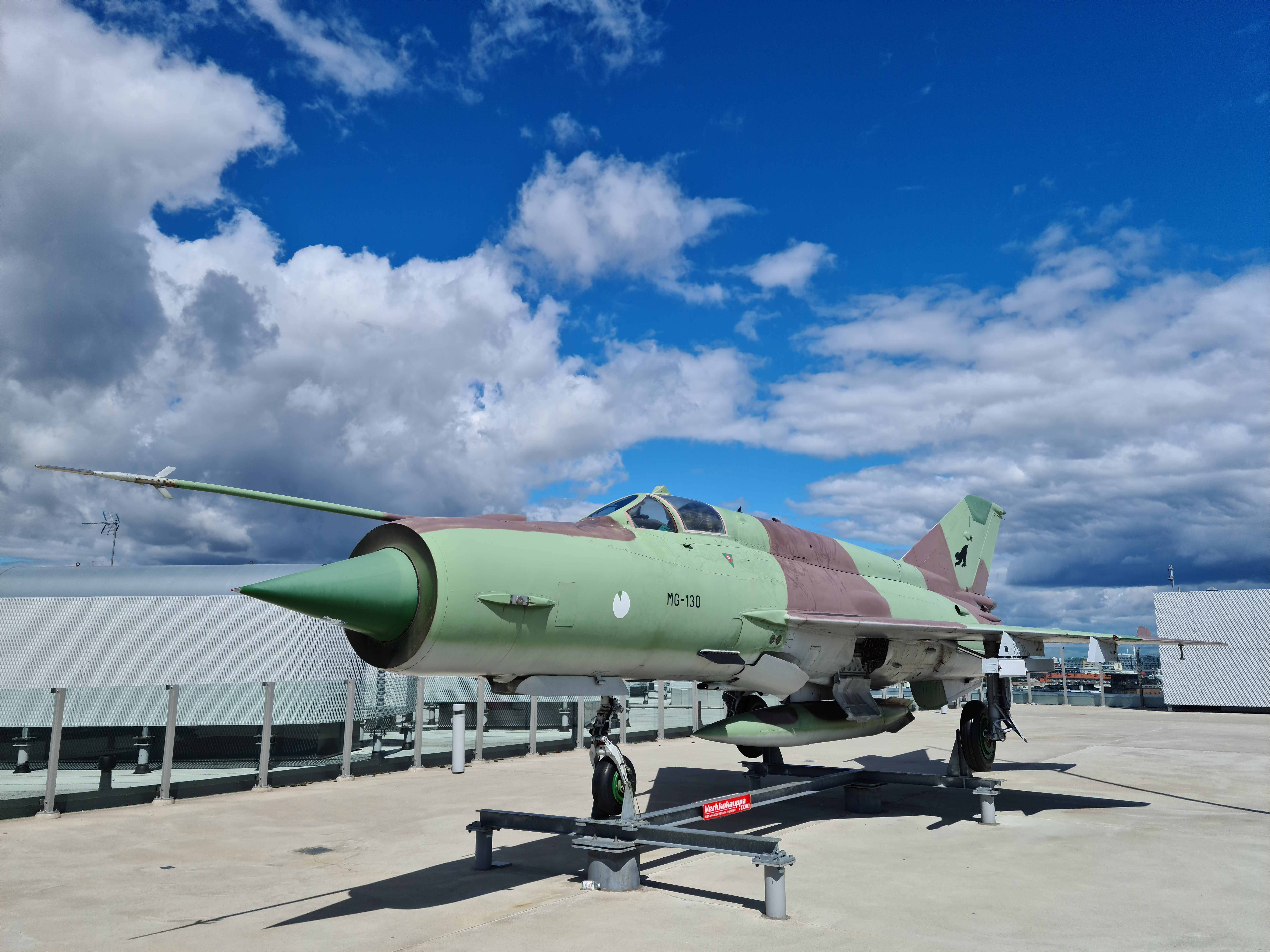|
MiG-23
The Mikoyan-Gurevich MiG-23 (; NATO reporting name: Flogger) is a variable-geometry fighter aircraft, designed by the Mikoyan-Gurevich design bureau in the Soviet Union. It is a third-generation jet fighter, alongside similar Soviet aircraft such as the Su-17 "Fitter". It was the first Soviet fighter to field a look-down/shoot-down radar, the RP-23 Sapfir, and one of the first to be armed with beyond-visual-range missiles. Production started in 1969 and reached large numbers with over 5,000 aircraft built, making it the most produced variable-sweep wing aircraft in history. The MiG-23 remains in limited service with some export customers. The basic design was also used as the basis for the Mikoyan MiG-27, a dedicated ground-attack variant. Among many minor changes, the MiG-27 replaced the MiG-23's nose-mounted radar system with an optical panel holding a laser designator and a TV camera. Development The MiG-23's predecessor, the MiG-21, was fast and agile, but limited ... [...More Info...] [...Related Items...] OR: [Wikipedia] [Google] [Baidu] |
Mikoyan MiG-27
The Mikoyan MiG-27 (; NATO reporting name: Flogger-D/J) is a variable-sweep wing, variable-sweep attack aircraft, ground-attack aircraft, originally built by the Mikoyan, Mikoyan-Gurevich design bureau in the Soviet Union and later licence-produced in India by Hindustan Aeronautics as the ''Bahadur'' ("Valiant"). It is based on the Mikoyan-Gurevich MiG-23 fighter aircraft, but optimised for air-to-ground attack. Unlike the MiG-23, the MiG-27 did not have widespread use outside Russia, as most countries opted for the Mikoyan-Gurevich MiG-23, Mikoyan-Gurevich MiG-23BN and Sukhoi Su-22 instead. As of late 2023, all Russian, Indian, Sri Lankan, Ukrainian, and Kazakh MiG-27s have been retired, bringing the type's service to an end. Design and development The MiG-27 shares the basic airframe of the MiG-23, but with a revised nose – nicknamed "''Utkonos''" ("Platypus") or "''Gena the Crocodile, Krokodil Gena''" in Russian service, first introduced on the MiG-23B. Dissatisfaction ... [...More Info...] [...Related Items...] OR: [Wikipedia] [Google] [Baidu] |
RP-23 Sapfir
The RP-23 ''Sapfir'' ( NATO codename: ''High Lark)'' was a Soviet look-down/shoot-down radar system. It was developed by Phazotron specifically for the Soviet Air Forces (VVS) new MiG-23 fighter aircraft and used in conjunction with the Vympel R-23 (NATO codename: AA-7 ''Apex'') beyond visual range air-to-air missile. Variants ;Sapfir-23L The initial production version, the Sapfir-23L (L - ''Lyogkiy'' or lightweight) pulse radar was first carried on the MiG-23 Edition 1971. Using a twist-Cassegrain antenna in diameter, it used a continuous-wave target illuminator channel to provide guidance for the semi-active radar homing (SARH) R-23R missile. However, as an interim variant it was considered unreliable and lacked the look-down/shoot-down capability of later Sapfir radars; it could only guide missiles onto targets flying above .Mladenov (2016), Ch. 3 - ''MiG-23 Edition 1971''Mladenov (2016), Ch. 3 - ''MiG-23 Radars'' ;Sapfir-23D Equipping the MiG-23M, the improved Sapfir-23D h ... [...More Info...] [...Related Items...] OR: [Wikipedia] [Google] [Baidu] |
Syrian Air Force
The Syrian Air Force () is the air force branch of the Syrian Armed Forces. It was established in 1948, and first saw action in the 1948 Arab–Israeli War. Under Ba'athist Syria until December 8, 2024, it was known as the Syrian Arab Air Force. Land-based air defense systems were grouped under the Syrian Air Defence Force, which split from both the Air Force and the Army. As of March 2025, the air force status is unknown, with some of its equipment being lost following the Hay'at Tahrir al-Sham and other rebel groups offensive in November 2024 and subsequent Israeli Air Force's airstrikes in December 2024, following the collapse of the Assad regime. History 1940s The end of World War II led to the withdrawal of the United Kingdom and France from the Middle East, and this included a withdrawal from Syria. In 1948, the Syrian Air Force was officially established after the first class of pilots graduated from a French-run flight school at Estabel airfield in Lebanon, usi ... [...More Info...] [...Related Items...] OR: [Wikipedia] [Google] [Baidu] |
Mikoyan-Gurevich MiG-21
The Mikoyan-Gurevich MiG-21 (; NATO reporting name: Fishbed) is a supersonic jet fighter and interceptor aircraft, designed by the Mikoyan-Gurevich Design Bureau in the Soviet Union. Its nicknames include: "''Balalaika''", because its planform resembles the stringed musical instrument of the same name; "''Ołówek''", Polish for "pencil", due to the shape of its fuselage, and "''Én Bạc''", meaning "silver swallow", in Vietnamese. Approximately 60 countries across four continents have flown the MiG-21, and it still serves many nations seven decades after its maiden flight. It set aviation records, becoming the most-produced supersonic jet aircraft in aviation history, the most-produced combat aircraft since the Korean War and, previously, the longest production run of any combat aircraft. Development Origins The MiG-21 jet fighter was a continuation of Soviet jet fighters, starting with the subsonic MiG-15 and MiG-17, and the supersonic MiG-19. A number of experime ... [...More Info...] [...Related Items...] OR: [Wikipedia] [Google] [Baidu] |
Sukhoi Su-17
The Sukhoi Su-17 (''izdeliye'' S-32; NATO reporting name: Fitter) is a variable-sweep wing fighter-bomber developed for the Soviet military. Developed from the Sukhoi Su-7, the Su-17 was the first variable-sweep wing aircraft to enter Soviet service and featured updated avionics. The aircraft also has variants which were designed to be exported to non-Soviet states such as the Sukhoi Su-22 and the less popular Su-20. It was produced from 1967 to 1990. The Su-17/20/22 series had a long career and has been operated by many air forces, including those of the Russian Federation, former Soviet republics, former Warsaw Pact, countries in the Arab world, Angola, and Peru. The Russian Federation retired its fleet in 1998. Although the Su-17 was capable of carrying nuclear weapons, it was used in roles ranging from close-air support to ground attack. Development Shortly after the Su-7 fighter-bomber was put into service, the Sukhoi Design Bureau was ordered to develop a modernization ... [...More Info...] [...Related Items...] OR: [Wikipedia] [Google] [Baidu] |
Soviet Air Force
The Soviet Air Forces (, VVS SSSR; literally "Military Air Forces of the Union of Soviet Socialist Republics"; initialism VVS, sometimes referred to as the "Red Air Force") were one of the air forces of the Soviet Union. The other was the Soviet Air Defence Forces. The Air Forces were formed from components of the Imperial Russian Air Service in 1917, and faced their greatest test during World War II. The groups were also involved in the Korean War, and dissolved along with the Soviet Union itself in 1991–92. Former Soviet Air Forces' assets were subsequently divided into several air forces of former Republics of the Soviet Union, Soviet republics, including the new Russian Air Force. The "Air March, March of the Pilots" was its marching song. Origins The first military aviation branch of Russia or any of the Soviet Union's constituent states was the short-lived Imperial Russian Air Service, founded in 1912 and disbanded in 1917 with the onset of the Bolshevik Revolution and ... [...More Info...] [...Related Items...] OR: [Wikipedia] [Google] [Baidu] |
Swing-wing
A variable-sweep wing, colloquially known as a "swing wing", is an airplane wing, or set of wings, that may be modified during flight, swept back and then returned to its previous straight position. Because it allows the aircraft's shape to be changed, it is a feature of a variable-geometry aircraft. A straight wing is most efficient for low-speed flight, but for an aircraft designed for transonic or supersonic flight it is essential that the wing be swept. Most aircraft that travel at those speeds usually have wings (either swept wing or delta wing) with a fixed sweep angle. These are simple and efficient wing designs for high speed flight, but there are performance tradeoffs. One is that the stalling speed is increased, necessitating long runways (unless complex high-lift wing devices are built in). Another is that the aircraft's fuel consumption during subsonic cruise is higher than that of an unswept wing. These tradeoffs are particularly acute for naval carrier-based a ... [...More Info...] [...Related Items...] OR: [Wikipedia] [Google] [Baidu] |
K-13 (missile)
The Vympel K-13 (NATO reporting name: AA-2 "Atoll") is a short-range, infrared homing air-to-air missile developed by the Soviet Union. The K-13 is a reverse engineered copy of the American AIM-9 Sidewinder, hence the similar appearance. Although it since has been replaced by more modern missiles in front-line service, it saw widespread service in many nations. Background During the Second Taiwan Strait Crisis in 1958, Taiwan's F-86 Sabres faced the much higher performance mainland Chinese PLAAF MiG-17s. The MiG-17s had speed, maneuverability, and altitude advantages over the Sabres, allowing them to engage only when they desired, normally at advantageous times. In response, the US Navy rushed to modify 100 ROCAF Sabres to carry the newly introduced AIM-9 Sidewinder missile. These were introduced into combat on 24 September 1958, when a group of MiG-17s cruised past a flight of Sabres, only for them to be attacked by missiles. This was the first instance of guided missiles bein ... [...More Info...] [...Related Items...] OR: [Wikipedia] [Google] [Baidu] |
Bulgarian Air Force
The Bulgarian Air Force () is one of the three branches of the Military of Bulgaria, the other two being the Bulgarian Navy and Bulgarian land forces. Its mission is to guard and protect the sovereignty of Bulgarian airspace, and jointly with the other branches, to protect territorial integrity. The Bulgarian Air Force is one of the oldest air forces in Europe and the world. In recent times it has been actively taking part in numerous NATO missions and exercises in Europe. The current commanding officer of the Bulgarian Air Force is Major General Nikolai Rusev. History Early years The Bulgarian Air Force dates back to the end of the 19th century. At the 1892 Plovdiv International Fair, two lieutenants of the Bulgarian Army flew in the 'La France' balloon owned by the Frenchman Eugène Godard.Nedialkov, D. "Air Power of the Kingdom of Bulgaria. Part I" Later, inspired by the flight, they succeeded in convincing the Bulgarian General Staff that the Army should build a ba ... [...More Info...] [...Related Items...] OR: [Wikipedia] [Google] [Baidu] |
Lift Jet
A lift jet is a lightweight jet engine installed only for upward thrust.{{cite book , url=https://archive.org/details/cambridgeaerospa0000guns/page/346/mode/2up , isbn=978-0-521-84140-5 , title=The Cambridge aerospace dictionary , date=2004 , last1=Gunston , first1=Bill , publisher=Cambridge University Press An early experimental program using lift engines was the Rolls-Royce Thrust Measuring Rig (TMR), nicknamed the "Flying Bedstead", first run in 1955. In the early 1960s both the Soviet Union and Western nations considered lift engines to provide STOL or even VTOL capability to combat aircraft. The Soviet Union did concurrent testing of versions of combat aircraft using swing-wing, variable geometry wings or lift jets but ruled out lift jets. Problems associated with lift engines include high fuel consumption, extra weight (which is simply dead weight when the engines are not needed for lift), and taking up fuselage volume that could be used for fuel or other systems. I ... [...More Info...] [...Related Items...] OR: [Wikipedia] [Google] [Baidu] |
Mikoyan-Gurevich 23-01
The Mikoyan-Gurevich 23-01, aka ''Izdeliye 92'' and (erroneously) Mikoyan-Gurevich MiG-23PD, NATO reporting name Faithless, was a 1960s STOL fighter / attack aircraft, designed in the USSR The Union of Soviet Socialist Republics. (USSR), commonly known as the Soviet Union, was a List of former transcontinental countries#Since 1700, transcontinental country that spanned much of Eurasia from 1922 until Dissolution of the Soviet ..., to fulfil a requirement for ground-attack and fighter aircraft able to operate from short runways. Specifications (23-01) References {{DEFAULTSORT:Mikoyan-Gurevich 23-01 Mikoyan aircraft, 23-01 1950s Soviet fighter aircraft Delta-wing aircraft Mid-wing aircraft Aircraft first flown in 1967 STOL aircraft ... [...More Info...] [...Related Items...] OR: [Wikipedia] [Google] [Baidu] |





